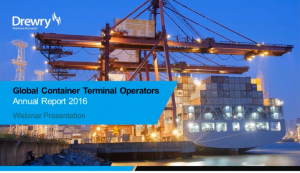 On October, 18th Drewry held a webinar on the Global Container Terminal Operators Annual Review recently released by the company and now presented by Neil Davison, Senior Analyst, Ports and Terminals. The report, published annually for the last 14 years, provides comprehensive and enhanced analysis of terminal operators’ activity and has become an industry “bible”.
On October, 18th Drewry held a webinar on the Global Container Terminal Operators Annual Review recently released by the company and now presented by Neil Davison, Senior Analyst, Ports and Terminals. The report, published annually for the last 14 years, provides comprehensive and enhanced analysis of terminal operators’ activity and has become an industry “bible”.
As usually the report presents the throughput ranking based on total TEU and equity TEU measures. The top-5 terminal operators range as follows.
Total TEU measure
Total throughput of all terminals in which an operator has a stake of more than 10%, excluding any stakes in other operators
Terminal Operator Throughput 2015, mln TEU Growth/Decline
Hutchison Ports 81.0 +1.1%
APM Terminals 69.3 -3.3%
PSA International 63.8 -2.1%
Cosco Group 62.8 +1.4%
DP World 60.5 +3.1%
Equity TEU measure
Throughput of each terminal adjusted on pro rata basis depending on the size of the shareholding in the terminal, includes stakes in other operators| Terminal Operator | Throughput 2015, mln TEU | Growth/Decline |
|---|---|---|
| PSA International | 53.1 | -3.7% |
| Hutchison Ports | 47.0 | -0.1% |
| DP World | 37.0 | +3.3% |
| APM Terminals | 35.9 | -3.0% |
| China Merchants Port Hds. | 26.3 | +2.0% |
Relatively small dynamics in the annual throughput reflects the unprecedented situation faced currently by the terminal industry, which Drewry calls “perfect storm”. It is a complex of 4 main challenges: softening of global demand growth (less than 3% per year, as forecasted by Drewry for the next 5 years), higher capex and opex costs due to handling bigger ships, increased business risks from dealing with larger liner alliances and constant pressure on the part of carriers for lower prices for terminal handling services.
As a result of slowdown in demand and increased risks and challenges in terms of returns, all capacity expansion plans are under review by terminal operators, with great deal of caution in terms of greenfield projects. Thus, in 2006 there were about 47 confirmed greenfield terminal developments by the stevedores, in 2016 their number declined to 32. And carriers almost ceased this activity at all.
This year’s report highlights increased merger and acquisition (M&A) activity as the key strategic approach for growth, risk mitigation and opportunities in the current conditions. Drewry forecasts the number of terminal operators (now 24) may fall next year due to M&A, changing the operator landscape. Drewry singles out 2 main types of M&A deals going on. One is consolidation, examples being Cosco merging with China Shipping, CMA CGM acquiring APL, APM Terminals acquiring Grup TCB. Second type is strategic alliances, such as Hutchinson selling its stake in Euromax terminal in Rotterdam to Cosco China Shipping, PSA International establishing JVs in Singapore for terminals with CMA CGM and Cosco, finally a recent deal of APM Terminals with Cosco Shipping Ports in Vado, Italy.
Among the key research findings a new tendency for investors was mentioned, which is the move of the industry from growth sector towards a value sector, albeit still highly profitable. This implies that instead of looking for the above average growth in the industry the investors are now looking for the companies undervalued by the market.
In the Q&A session following the main part of the webinar, Neil Davison agreed that there is a significant risk of facing a lack of terminal capacity in the future, given the slowdown in port development.
“Terminal operators are being very cautious with adding new capacity and will be for the years to come. And demand can be dynamic and change quickly but terminal capacity is very slow to change. So if there is a recovery in demand growth, it will take time to react”, he explained. “And shipping lines have to be careful on the question of prices for handling services. If terminal operators are pushed too far down with prices, they may simply say they will not invest and then we could end up with lack of capacity in key locations. There is this risk, may be not in the short term, but in the medium or long term.”
Got interested? Feel free to read the review of the latest Drewry report – 3Q 2017 Ports & Terminals Insight here.
